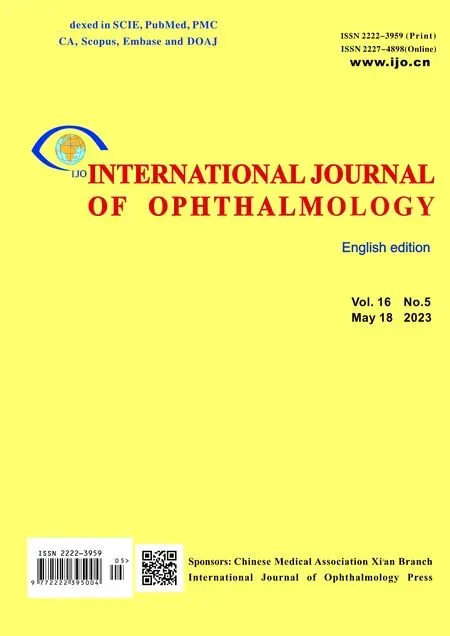Comment on “Factors affecting single-step transepithelial photorefractive keratectomy outcome in the treatment of mild, moderate, and high myopia: a cohort study”
Suraj Kumar Chaurasiya, Vishmarika Sharma, Pradeep Agarwal
1Department of Optometry and Ⅴision Science, C L Gupta EyeⅠnstitute, Ram Ganga Ⅴihar Phase ⅠⅠ (Extn.), Uttar Pradesh,Moradabad 244001, India
2Department of Paediatric and Neuro Ophthalmology, C L Gupta Eye Ⅰnstitute, Ram Ganga Ⅴihar Phase ⅠⅠ (Extn.), Uttar Pradesh, Moradabad 244001, India
Dear Editor,
I would like to congratulate the author on their excellent paper.With great interest, I read Al-Mohaimeedet al’s study[1]“Factors affecting single-step transepithelial photorefractive keratectomy outcome in the treatment of mild,moderate, and high myopia: a cohort study”.
In this original article, it has been mentioned that “the myopia is grades as mild (<‐3 D) and severe (≥‐6 D)”.However, earlier authors stated that when considering the quantitative limits and definitions of myopia, one issue warranting standardization is the use of statistical comparison symbols (e.g., <, >, ≤, and≥) and non‐mathematical terms indicating a larger or smaller number.Myopic refractions are best expressed as negative values of diopters.Myopic regression is best expressed as negative values of diopters.This creates potential ambiguity when comparing degrees of myopia.For example, does “<5.00 D”mean a refractive error more myopic than 5.00 D or a refractive error less myopic than 5.00 D? Both definitions are widely used.Optics is a very mathematical science, and any quantitative explanations must be mathematically valid.The most consistent approach is always to treat myopic refractive errors as negative values and to use mathematical terms in their strict mathematical sense, so <5.00 D of myopia means refractive errors with values greater than a minus, and,therefore, myopic greater than 5.00 D[2-5].
Ⅰf the description is made in words and mathematical figures(such as being less than a negative number of diopters), then refraction of “less than 5.00 D”should be explained as “more myopic”.Ⅰf myopia is defined as a positive dioptric value, then the constant statistical method shows that “more than 5.00 D of myopia”represents an additional objection is myopic than 5.00 D.Similarly, phrases such as “high levels of myopia”should be interpreted as more myopic prescriptions[2].It would be simpler for everyone if the author can additionally concentrate on specific sorts of symbols.However, this study showed a very useful result that one-step transepithelial photorefractive keratectomy has promising short-term results for refractive correction and improvement of vision to treat all three degrees of myopia[1].
ACKNOWLEDGEMENTS
Conflicts of Interest: Chaurasiya SK,None;Sharma V,None;Agarwal P,None.
 International Journal of Ophthalmology2023年5期
International Journal of Ophthalmology2023年5期
- International Journal of Ophthalmology的其它文章
- Visual function and biofeedback training of patients with central vision loss: a review
- A case of Posner-Schlossman syndrome treated by gonioscopy-assisted transluminal trabeculotomy
- Mitochondrial dysfunction in glaucomatous degeneration
- Publication trends of primary angle-closure disease during 1991-2022: a bibliometric analysis
- Improving myopia awareness via school-based myopia prevention health education among Chinese students
- Ocular manifestations of children with atopic dermatitis in Saudi Arabia
